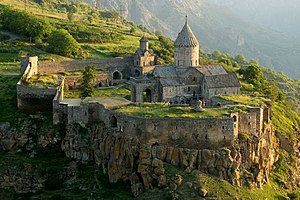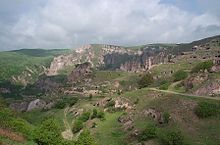
Goris is a city in Southern Armenia. Goris is a favoured destination of many local and foreign tourists, with a lot of hotels and inns. The stone-pyramids of Old Kores are one of the most attractive sites in Goris.
Understand
The city was possibly the first built in a grid layout in Armenia, with a very quaint regional style of stone architecture. Goris is the last major town in Armenia for travelers continuing to Karabakh. It's also quite difficult to get to Kapan or Meghri, and thus Iran without passing through Goris, making this the gateway of the South.
Though Goris or Tatev can be crammed into a day trip from Yerevan, it's much better to spend a few nights in the area, and along the way.
History
Throughout its history, Goris has also been known as Kores and Gorayk. The name Goris had many variants including: Goristsa, Kores, Gores, Gorayk, Goru, and Geryusy.
The Goris area has been settled since the Stone Age and is first mentioned in the Urartian period, when King Rusa I of Urartu who reigned between 735 and 713 BC, left a cuneiform, where he mentioned that among the 23 countries conquered by him, Goristsa country was one of them, which is believed to be Goris.
During the Middle Ages, there was a town-settlement in the eastern part of the present Goris, on the left bank of Goris river, called Kores. Between the 12th and 15th centuries, it suffered from the Seljuk, Mongol, Aq Qoyunlu and Kara Koyunlu invasions, respectively.
At the beginning of the 16th century, it became part of Safavid Persia. The current spelling of the name was first mentioned in 1624.At the beginning of the 18th century, the region was the centre of the Armenian liberation campaign led by David Bek, against Safavid Persia and the invading Ottoman Turks. In 1750, the region became part of the newly-formed Karabakh Khanate.
At the beginning of the 19th century, it became part of the Russian Empire. Under Russian rule, the town of Goris was founded in 1870 to become the centre of Zangezursky Uyezd, within the Elisabethpol Governorate of the Russian Empire. In 1876, the construction of new Goris was completed near the old town of Kores,
It was part of the first Republic of Armenia from 1918 until 1920, when following the fall of the republic, it became in 1921 the de facto capital of the self-governing regions of Daralakyaz (Vayots Dzor), Zangezur, and parts of Mountainous Artsakh, under the name of the Republic of Mountainous Armenia. However, the self-proclaimed republic only lasted months until the Red Army forced it to capitulate on 13 July 1921.
Under the Soviet rule, Goris served as a regional centre. During the 1950s, the economy of the city was boosted by the construction of many hydroelectric power plants in the area.
Orientation
Goris stands 254 km (158 miles) south of Yerevan, in a valley surrounded by the Zangezur Mountains, through which flows the Goris River, also known as Vararak River. The town is approximately 10 km from the Azerbaijani border and about 70 km from the Iranian border, and has an average elevation of 1,385 metres above sea level.
Climate
Inside an alpine climate zone, the weather of Goris is characterized with mild snowy winters and hot summers. The average temperature in January is –1.3 °C and 19 °C in July. The annual precipitation level is between 500 and 600 mm.
Tourism information office
- Tourist Information Center, off Komitas St at Ankakhutyan 3 (opposite the Archaeological Museum), ☏ 374 43 189923. The helpful staff can offer assistance in English, French, Russian and Armenian. They have the marshrutka timetable for the surrounding area.
Get in

By bus
- 1 Bus stop 1 from Yerevan (Komitas St. between Mashtots St. and Orbelyanner St.).
- 2 Bus stop 2 from Yerevan (Komitas St. between Syuniq St. and Movses Khorenatsi St.).
From specific destinations:
- Yerevan – Marshrutkas depart from the Southern Bus Station, at 09:00 and 16:00, cost 2,500 dram, and take 6 hr. (They return from Goris when full, the first one at 09:00. It is prudent to book in advance by phone (the day before), as they get filled up. Ask you accommodation or the tourist information.)
- Alternatively, take a marshrutka going to Stepanakert and get dropped in Goris. These leave from the Kilikia Bus Station every 30 min or so, in the mornings from 07:00. They cost 5,000 dram as you need to pay for the full journey even if you get dropped early. Nevertheless, you can always try to haggle.
- Sisian – One daily marshrutka departs for Goris at 10:30 on Monday, Wednesday and Friday, stopping at Goris en route to Stepanakert (2,000 dram). Alternatively, you can wait at the highway for a marshrutka to pass through from Yerevan (four or five pass through every afternoon); they'll pick you up if there is space.
- Kapan – At 09:00 and 12:00, 1,500 dram, 1½-2 hr.
- Tatev – At 07:30 and 14:30, 700 dram, 1 hr.
- Stepanakert – At 14:30, 2,000-2,500 dram, 2 hr. Otherwise take any that goes to Sisian or Yereven, and get of at the highway near Goris. Though, they might only take you along if you pay for the full distance, or if seats are unoccupied.
By taxi
Regular shared taxis (4,500 dram per person, 4½ hr) depart daily from Yerevan between 09:00 and 13:00, and return from Goris in the afternoon. (They depart Goris from an unmarked door on Syuniki St. near the post office.) The shared taxis stop for a food break at Yeghegnadzor.
By car
Renting a car (with or without driver/guides) or taking a private cab is a more flexible, expensive option. A private transfer costs around 27,000 dram and can be arranged with stops along the way and further to Tatev. This can be worthwhile if you are in a group or short on time to see lots of places along the way.
Get around
Within Goris, it is quite easy to get around on foot.
Marshrutkas to nearby villages operate from the market on Syuniki street.
See
.jpg/220px-2014_Prowincja_Sjunik,_Goris,_Kościół_św._Grzegorza_Oświeciciela_(03).jpg)
_(12).jpg/220px-2014_Prowincja_Sjunik,_Goris,_Widok_na_Stary_Goris_(Kores)_(12).jpg)

In town there's a church, a market, the Axel Bakunts Museum and some other minor sites. On the edges of town are some great rock formations which are attractive to photographers.
- Aksel Bakunts museum. Aksel Bakunts was a famous Armenian writer. The house museum is worthy of a visit regardless whether you are a fan of his writing, as it's an interesting example of what a traditional home would have looked like in his time. The surrounding neighbourhood sports plenty of 19th century houses.
- St. Grigor Lusavorich Church, corner of Grigor Tatevatsi and Mesrop Mashtots. This church is dedicated to Gregory the Illuminator, the patron saint of Armenia. Built in 1897-1904, it was consecrated in 1903 by Catholicos Khrimian Hayrik and opened the following year without a dome or altar. The coming of the Soviets resulted in it being closed in 1926. Until the 1960s, the church was used to store grain and as a geological museum. In December 1989, the church was reopened, still in an unfinished state. Between 1984 and 1997, the dome and a holy altar were completed, and after being blessed on 20 December 1997, it's fully operational today. Before the dome was added, the church was 12 metres high, but today, with dome and the cross, it is 28 metres high.
Nearby:
- 1 Old Khndzoresk Cave Village (Hin Khndzoresk) (a couple of villages east of Goris is the village of Khdzoresk, and under it, in a gorge pocked with caves is Old Khndoresk). Until the 1950s, people lived in those caves still, and this was an active cave village, so be careful who you call a caveman around here!
- 2 Bgheno-Noravank Monastery (16 km south of Goris). A couple of kilometres off the main highway is the little known and less visited monastery of Bgheno Noravank. Easy to miss the turnoff, and just consisting of a couple of chambers, it's a good spot for a break if you're on a long drive.
- 3 (8 km north of the Karabakh entry checkpoint - without entering). A very ancient monastery that has been renovated.
Do
- 1 Goris Wildlife Sanctuary (at the southeast of the town). At a height of 1,400-2,800 m above sea level with an area of 18.5 km². Caucasian grouse, roe deer and brown bear are among the notable animals in the sanctuary. With the closeness of the sanctuary to Azerbaijan and actually spreading across the border, get up to date information of border safety when heading there.
Buy
- Samovar seller. There is a roadside stand with a large collection of antique samovars for sale that are beautiful to look at, whether or not you intend to purchase one.
Eat
There are one or two restaurant/cafes in town, and a few barbecue joints on the highway on the edge of town.
Drink
Where there is food, there is drink.
Sleep
- 1 Aregak B&B, 4/16 Getapnya, ☏ 374 937 66525, ✉[email protected]. Lovely B&B close to the centre of Goris, in a separate apartment to the host. Great breakfasts, tea and coffee. The apartment has two triple rooms and one double, kitchen, TV, and fridge. Host can arrange transport to Tatev and onwards. 5,000 dram.
- 2 Khachik B&B, 13 Davit-Bek St., ☏ 374 284 21098, 374 91 204012, ✉[email protected]. A B&B that's been a fixture for visitors for many years. Friendly owners that brew wine in their own home. You can have pre-ordered meals as well; dinner per person is 4,000 dram. Trying the wine is also extra. The hosts can arrange a taxi to go to the cable car to Tatev and wait at Devil's Bridge while you walk down from the monastery, 8,000 dram round trip (10,000 dram if you want the cab to go all the way to the monastery).
- 3 Mirhav, 100 Mashtots Str., ☏ 374 284 24612, ✉[email protected]. Fantastic design/decor, very "Armenian" while still being comfortable and modern. Excellent staff, beautiful garden, good food. 18-33,000 dram.
Go next
- Tatev – Tatev is on an 850 m high cliff above a natural land bridge, springs, a cavern in an underground river. It is an unforgettable place. The town, its monastery and the cable car that leads there, are only the important sights to discover there.
- Jermuk – A spa town where much of the country's mineral water comes from.
- Sisian – A good base for visiting Ughtasar mountain and thousands of petroglyphs on top of it.
- Yeghegnadzor – A small town close to spectacular canyon and monastery in Noravank, the impressive Smbatabert Fortress/Tsakhats Kar Monastery area and the old silk road caravanserai of Selim.
